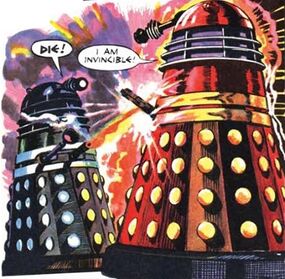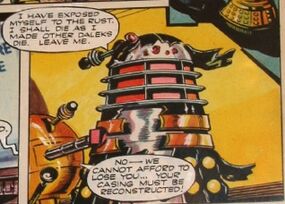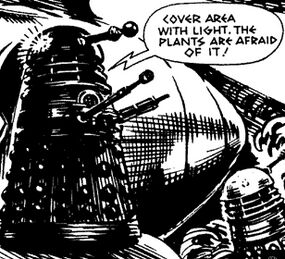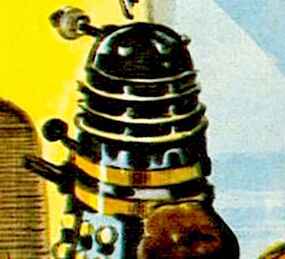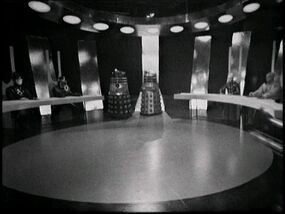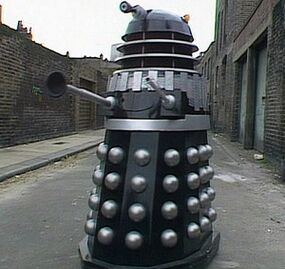Black Dalek Leader
The Black Dalek Leader, (COMIC: Plague of Death) usually just referred to simply as the Black Dalek, and briefly as Searcher One Leader, (COMIC: The Archives of Phryne) was the earliest Black Dalek in existence and the second-in-command of the Dalek race, after the Dalek Prime, (COMIC: Plague of Death, The Secret of the Emperor; PROSE: The Mutation of Time, The Evil of the Daleks) serving as the Daleks' warlord. (COMIC: The Secret of the Emperor, PROSE: The History of the Daleks)
The Black Dalek Leader also held the rank of Dalek Supreme, (TV: The Daleks' Master Plan) as during its reign it did not remain the only Black Dalek in existence, (PROSE: Legacy of the Daleks; AUDIO: The Destroyers, Masters of Earth, The Curse of the Daleks, Return to Skaro) with the Dalek Emperor having several "Black Dalek Leaders" (TV: The Evil of the Daleks) at a point when it believed the original Black Dalek to be dead. (PROSE: The Evil of the Daleks)
Nevertheless, it was uniquely valuable to the Dalek Prime, who considered it "irreplaceable". (PROSE: The Mutation of Time) Along with Prime and the Red Dalek Leader, the Black Dalek was part of the leading triumvirate of the Dalek City. (COMIC: The Dalek Trap, Shadow of Humanity, Return of the Elders) According to one account, it adopted the designation of Dalek Supreme after it became the last survivor of the Dalek Council of Supreme Daleks. (PROSE: Dalek: The Astounding Untold History of the Greatest Enemies of the Universe)
Biography
Establishing power on Skaro
The Black Dalek Leader was summoned by the Emperor to deal with Zeg after he challenged the Emperor's authority. Its weapon was unable to penetrate Zeg's metalert casing. (COMIC: Duel of the Daleks)
When the Daleks developed a means of space travel, the Emperor led an invasion force off Skaro to conquer other planets, (COMIC: The Amaryll Challenge) leaving the Black Dalek in charge of the Dalek City. When the Daleks were threatened by the outbreak of a rust plague, the Black Dalek was infected in such as way that it could be used as a vessel to transmit the plague to other Daleks. The Emperor returned to Skaro to deal with the situation. The Emperor's guards chased the Black Dalek away to protect the Emperor. The Emperor then found the Black Dalek by the Brain Machine, rusting away, resigned to its fate, ashamed as it was of letting other Daleks die. The Emperor claimed the Black Dalek was too valuable to lose and sent it to the recasting furnace to be repaired. (COMIC: Plague of Death)
Leading the early conquests
After its recovery, the Black Dalek led a force of Daleks in search of new technologies as war with the Mechanoids became evermore certain. The Black Dalek discovered an entire solar system hidden behind an invisibility shield and then directed the fight against Phryne. The Daleks successfully occupied the planet, although many Phrynians went into hiding to form a resistance movement. (COMIC: The Archives of Phryne)
The Black Dalek led an attack on the rebuilt Mechonoid City on Mechanus against the Mechonoids and Gubbage Cones after they traced their Mechanical Planet there. The attack was successful and the city was destroyed but a surviving Mechonoid swore revenge. (COMIC: The World That Waits)
The Emperor called a meeting with the Black Dalek and a Red Dalek when the presence of the One in a Million Dalek threatened to cause a civil war. (COMIC: Shadow of Humanity) Both were also present on the Emperor's ship when the Daleks first ventured into the Sol System (COMIC: Return of the Elders) after the Daleks discovered the location of Earth. (COMIC: The Road to Conflict) They were repelled by the Elders, but the Elders foresaw that after falling back and regrouping, the Daleks would make a second bid at dominating the Earth, which would be stopped by "another". (COMIC: Return of the Elders)
22nd century Dalek invasion
[[File:Supreme Controller.jpg|thumb|right|The Black Dalek during the Dalek occupation of Earth. (TV: The Dalek Invasion of the Earth)In 2157, the Daleks finally began a decade-long occupation of Earth and its colonies. (TV: The Dalek Invasion of Earth) The same Black Dalek who acted as the Dalek Prime's second-in-command and Warlord (PROSE: The History of the Daleks) was made Supreme Controller of the operation, directing the Dalek Earthforce and the Bedfordshire operation. The Supreme Controller oversaw Dalek activities from on-board the "alpha-major" Dalek flying saucer, along with its Dalek Saucer Commander. It had a terrifying "pet" Slyther which it used to let roam free around the mines at night, killing those it found. (TV: The Dalek Invasion of Earth, PROSE: Doctor Who and the Dalek Invasion of Earth)
The Supreme visited London during one of the daily saucer landings to collect more slave workers and Robomen. Among the prisoners taken were the First Doctor, Ian Chesterton, and Larry Madison. However that night an attack by the Human resistance was carried out, and the prisoners escaped. After a group of the rebels killed one of the Daleks, the Supreme exterminated any humans he saw. After the attack had been defeated, the Supreme Controller ordered that all humans involved in the attack to be destroyed, however he was unaware that Ian was hiding under the shafts directly under him. The supreme controller had the Robomen place fire bombs around the city.
As the saucer left for Bedfordshire, a van stolen from the museum had gone on to escape London, attacking patrol 5, prompting the Supreme Controller to order an immediate attack on the van, destroying it but failing to kill the rebel passengers. After landing in Bedfordshire, the Supreme Controller was the first to depart the saucer, arriving in the control room to observe the final stages of the operation. As the Daleks set the capsule in position and start the countdown, Ian, who was stuck inside, interfered with the wiring inside the capsule, disarming it. The supreme controller had the capsule brought back up, but a Dalek observing its ascent noticed Ian sneaking out from it, with the Supreme ordered Ian to to be exterminated. However, the Dalek only shot at the rope, believing Ian would die from the fall.
The captured Barbara Wright and Jenny were brought forward to the Controller, claiming to have information regarding a human rebellion; however the controller quickly realising they are lying had them restrained to ensure no more delays.
With the capsule re-armed, and ready, the Controller personally sent the capsule down towards its target. However, he was unaware it had been jammed by a cord of wood across the shaft opening, preventing a re-armed explosive capsule from moving further down the shaft. As the controller, and his aides left, the Doctor and Carl Tyler had entered the control room releasing Jenny and Barbara. The Doctor then accidentally sent an alarm to the Controller who ordered two of his aides to exterminate them.
David and Susan managed to destroy the radio beacon, leaving the Robomen adrift and causing a temporary overload within the Daleks, who short-circuited. Barbara and the Doctor gave new orders to the Robomen to destroy the Daleks. With the help of the Robomen, Wells and Tyler led the human slaves in rebellion, destroying any inert Daleks in their way and escaping the mine. The bomb exploded, destroying the Dalek fleet. (TV: The Dalek Invasion of Earth) According to other accounts, it was the influence of the Earth's magnetic core which spelled the end of the Dalek invasion. (TV: Genesis of the Daleks)
Time campaign against the Doctor
[[File:DaleksBeginChase.jpg|thumb|left|The Black Daleks orders the pursuit of the Doctor. (TV: The Chase)]]After the failure of the invasion, the Daleks identified the First Doctor and determined the role he played in their defeat. (TV: The Chase) The Black Dalek, acting under direct orders from the Dalek Prime, (PROSE: The Chase) ordered an assassination squad to pursue the Doctor's TARDIS in a Dalek time machine and exterminate the occupants while the Black Dalek and the Dalek Prime awaited regular reports on the progress from Skaro. However, the squad failed. (PROSE: The Chase) Some human historians believed that the Supreme Dalek had only launched on that particular mission much later in its (and the Daleks') history, spurred to action by the destruction of its fellow Dalek Councilmember the Gold Dalek. (PROSE: Dalek: The Astounding Untold History of the Greatest Enemies of the Universe)
On Skaro
On Skaro, the Black Dalek and the Red Dalek Leader collected two humans whose spaceship had been captured, Space Pilot Commander Don Morais and co-pilot Zec. The pair were brought to the Gold Dalek, who gave them the task of acquiring the doranium beneath Skaro's surface, threat of exposure to plasmoral constrictive gas. They discovered a cliff made of the substance in the Valley of Rocks, but rather than let the Daleks have it, Don short-circuited the electric charges in the doranium and together they escaped back to their ship. (COMIC: The Dalek Trap)
Overseeing the master plan
Beginning in the 36th century, the Daleks began the conquest of hundreds of planets in the Ninth Galactic System and the Constellation of Miros, avoiding human space for hundreds of years. (TV: Mission to the Unknown) In the 40th century, they finally returned and began preying on human space in secret. A subordinate Black Dalek informed the Black Dalek Leader, as the Supreme Dalek, about the success of the Dalek incursion on M5. (AUDIO: The Destroyers)
Shortly after, as the Daleks engaged in rising hostilities with the Space Security Service, (PROSE: The Outlaw Planet, COMIC: Sara Kingdom: Space Security Agent, The Brain Tappers) the Black Dalek Leader presided over the re-election of the Dalek Prime as Emperor, and itself as second in command. The Black Dalek obliterated the entire Red Extra-Galactic Squadron when their commander denounced the Emperor for failure to defeat the humans. (COMIC: The Secret of the Emperor)
In 4000, the Black Dalek oversaw the Dalek operations on planet Kembel. It led the conference which founded the Great Alliance with the emissaries from the Outer Galaxies, intent on invading the solar system. (TV: Mission to the Unknown; PROSE: Mission to the Unknown) It was, by then, the last surviving member of the Dalek Council, hence having adopted the title of singular Dalek Supreme. (PROSE: Dalek: The Astounding Untold History of the Greatest Enemies of the Universe)
Some months later, the Supreme Dalek held another conference as the Alliance completed preparations on the Time Destructor with the taranium supplied by Mavic Chen. The theft of the taranium by the First Doctor put the Black Dalek on edge, and it callously executed a number of its erstwhile allies, and even other Daleks, for failure during the recovery efforts. After the Daleks believed the core was recovered, the Supreme Dalek was informed it had been fitted into the Time Destructor for testing. (TV: The Daleks' Master Plan) However, the core was a fake. The Black Dalek called the Dalek Prime for assistance and the Red Dalek Leader led the pursuit of the Doctor. (PROSE: The Mutation of Time) After the successful recovery of the taranium core, the Black Dalek had the surviving members of the alliance locked up and prepared to complete the Time Destructor for the invasion fleet. However, the Doctor, Steven Taylor and Sara Kingdom managed to hijack the Time Destructor itself. The active weapon wiped out all Daleks on Kembel, seemingly including the Black Dalek. (TV: The Dalek's Master Plan)
The Black Dalek Leader was thought to have died on Kembel, which was a massive blow for the Dalek Empire as the Dalek Prime considered both the fleet and the Black Dalek irreplaceable. (PROSE: The Mutation of Time) This was also the Doctor's belief; when the Second Doctor returned to Skaro, he encountered another Black Dalek, and briefly wondered if it was the same one from Kembel, but, in his mind, the presence of further Black Daleks confirmed otherwise. (PROSE: The Evil of the Daleks)
It turned out to be the case, however, that the Black Dalek did survive the Time Destructor's detonation, though it was badly damaged and left in critical condition, having been recovered by attendants and brought back to Dalek territory. (PROSE: Dalek: The Astounding Untold History of the Greatest Enemies of the Universe) It was not the only survivor on Kembel but others were driven insane. (TV: Asylum of the Daleks) The Great War began in light of the Daleks' failure. (PROSE: The Evil of the Daleks)
After the Movellan campaign
The Dalek Supreme survived the Dalek-Movellan War, remaining the de-facto leader of the Dalek Empire, (PROSE: Dalek: The Astounding Untold History of the Greatest Enemies of the Universe) second only to the Dalek Prime. (PROSE: War of the Daleks) However, with the return of Davros near the end of the war, the Dalek creator was incensed to learn of the existence of the "Supreme Dalek". He declared the title was one he would "dispute most vigorously", believing that he himself should be Supreme Commander of the Daleks. (TV: Destiny of the Daleks) Eventually, the Movellans devastated much of the Dalek Empire in Mutter's Spiral by releasing the Movellan virus. Various Dalek Commanders began trying to reorganise the remnants of their respective sectors, but they were isolated from each other, leading to increased factionalism. (PROSE: Remembrance of the Daleks)
The Supreme Dalek planned to restore the Daleks to power through a series of ambitious schemes. Firstly, he planned to rescue Davros from cryogenic imprisonment and manipulate him into finding a cure for the Movellan virus. At the same time, he planned to capture the Fifth Doctor and his companions, Tegan Jovanka and Vislor Turlough, with a Time corridor and create duplicates of them, which would be sent back to Gallifrey to assassinate the High Council of the Time Lords. Additionally, he also planned to use human duplicates to infiltrate key positions in Earth's government positions, and cause their society to collapse in preparation for invasion. (TV: Resurrection of the Daleks)
With Dalek numbers greatly depleted following the war, the Supreme Dalek was forced to bolster his forces with Dalek Troopers, (PROSE: Remembrance of the Daleks) whose numbers consisted of hired humanoid mercenaries and mind-controlled duplicates. The commander of the troopers, Gustave Lytton, worked closely with the Supreme Dalek, though the two often disagreed on strategy, and the Supreme found Lytton to be too arrogant. (TV: Resurrection of the Daleks)
Sparking the Civil War
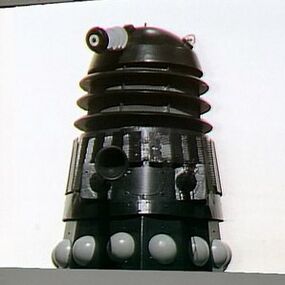
The attempt to free Davros from the space station which served as his prison was successful, but the Supreme Dalek's plan was put at risk by Davros' insistence that he remain close to his cryogenic chamber, and his refusal to board the Dalek ship. Lytton tried to convince the Supreme Dalek that there was no time to cater to Davros' demands, but the Supreme Dalek claimed to have a plan that would force Davros to leave with them of his own free will. In the meantime, he was determined that no harm come to Davros, as without his genetic expertise, the Dalek race had no future.
The plan to duplicate and Doctor and his companions also succeeded, but Davros proved to be greatly unreliable, and it soon became clear that he had no intention of helping the Daleks cure the Movellan virus. Instead, he converted two Daleks and several troopers to his cause and instigated a civil war against the Supreme Dalek for control of the Dalek race. Realising that Davros could not be trusted, the Supreme Dalek ordered Lytton to execute him. Lytton suggested simply shooting down the space station, but the Supreme Dalek, paranoid, insisted that he needed to see Davros dead.
When the troopers failed, he instead dispatched Daleks to carry out the task; however, these Daleks were killed by Davros, who had already released the Movellan virus onto the space station. The Supreme Dalek ordered Lytton to exterminate the Daleks and troopers loyal to Davros, then dispatched a squad of Daleks to execute Lytton when he had outlived his usefulness. A battle ensued between the Supreme's forces and those of Davros, which ended with more Daleks infected with the Movellan virus released by the Doctor. Lytton was one of the only survivors.
Although one of his plans had failed, the Supreme Dalek was confident that his duplicates on Earth would still bring about the collapse of society. Contacting the Doctor via the TARDIS scanner, the Supreme Dalek maintained that the Daleks could not fail. His gloating rant was cut off when Stien, an unstable Dalek duplicate, activated the space station's self-destruct, which destroyed the adjacent Dalek Battlecruiser, seemingly killing the Supreme Dalek. (TV: Resurrection of the Daleks) The Lives and Deaths of Davros, written by Lorraine Baynes, claimed as such. (PROSE: The Secret Lives of Monsters) However, the Supreme Dalek had been transmitting to the Doctor from "a secret location" and survived the event. (PROSE: Resurrection of the Daleks)
Far from leading the Daleks back to power, the Supreme Dalek's conflict with Davros accentuated the existing factionalism which existed within the remnants of the Dalek Empire. (PROSE: Remembrance of the Daleks) Davros returned with his own race of Daleks and sought to claim the the title of Emperor of the Daleks by defeating the "renegade" forces. The result was the Imperial-Renegade Dalek Civil War. (TV: Revelation of the Daleks, Remembrance of the Daleks)
Civil War and demise
When Renegade Daleks captured Davros for trial, he tried to convince them he was their master, to which they responded they obeyed only the Supreme Dalek. (TV: Revelation of the Daleks) According to one account, the Black Dalek was not present at Davros' trial, but did join the Golden Emperor in the Dalek Court Room after Davros escaped execution with the help of the Sixth Doctor. The two planned out the Daleks' next move together, namely plucking Abslom Daak out of his established time of death to use him to find the Seventh Doctor, and then force the Doctor to tel them where he had taken Davros in his previous incarnation.
After this ploy succeeded, the Black Dalek was present in the Dalek Interrogation Centre when the location of Davros's hideouts was extracted from the Doctor: Spiridon. It then led a large Dalek task-force to that planet with the intent of retrieving Davros. Instead, it discovered that, as the Doctor had anticipated, Davros had created a new race of Daleks loyal only to him. As they engaged the task-force in battle, the Black Dalek was forced to pull back and was eventually touched by gunfire from the opposite side, though not destroyed completely.
The Emperor was seemingly killed by the victorious Davros in his assault on the Dalek City, (COMIC: Emperor of the Daleks!) forcing the Dalek Supreme to act as de facto leader of the "Renegade Dalek" side of the War. (PROSE: Remembrance of the Daleks)
According to another account, the Golden Emperor was already nowhere in evidence on Skaro by the time Davros was taken to Skaro for his trial, with the Supreme Dalek instead acting as sole leader of the Empire. It planned to ascend to the rank of Dalek Emperor itself, and had an Imperial Casing prepared for the purpose: it intended to crown itself Emperor immediately after sentencing Davros to extermination.
However, at his trial, Davros turned the table on the Supreme by impressing the Dalek Council with his loyalty to the Daleks, intentionally passing up a choice to destroy the entire Dalek race. He demanded to be made Emperor in place of the Supreme, adapting the Imperial Casing to his needs. Hence, the Skaro-based Dalek Empire became Davros's Imperial Daleks while the Supreme Dalek went into hiding and became the leader of a faction of Renegade Daleks. (AUDIO: The Davros Mission)
In November 1963, it formed an alliance with the Association led by George Ratcliffe to obtain the Hand of Omega. It created a mind-link between itself and the human child Judith Winters to remedy its rigid Dalek mind's lack of imagination. (TV: Remembrance of the Daleks) Its connection with Judith Winters caused the Supreme Dalek problems; the girl's human emotions would filter into the Daleks' mind when she was accessing the battle computer, treating each problem as nothing more than a game, and causing strange thoughts for the Dalek.
Physically, the connection also made the Daleks' sluggish heartbeat race beyond the safety parameters, forcing the life-support computer in its casing to increase the amount of tranquilisers pumped into its body, making it difficult for the Dalek to concentrate properly. (PROSE: Remembrance of the Daleks) The Dalek Supreme ended up as the last surviving member of the Renegade Daleks present at the Shoreditch Incident after a skirmish with the Imperial Daleks, where the Hand of Omega was taken by the triumphant Imperials. The Seventh Doctor convinced it that it had no purpose. At this point, in a state of confusion and distress, it destroyed itself, breaking the link with Judith Winters. (TV: Remembrance of the Daleks)
Legacy
Following the Imperial-Renegade Dalek Civil War, the Dalek Emperor once again had a Dalek Supreme as his singular second-in-command. (AUDIO: Invasion of the Daleks) This Supreme was itself succeeded by another Dalek Supreme as head of the Dalek Empire in the absence of the Dalek Prime (AUDIO: Dalek War: Chapter Four, The Demons) before several other Daleks held the title during and after the Last Great Time War. (AUDIO: Desperate Measures, Homecoming, TV: Journey's End, Victory of the Daleks, The Magician's Apprentice)
In the Dalek Combat Training Manual, due to their somewhat different casings, the Time Lords misidentified the Supreme Dalek who pursued the First Doctor through time, the Supreme who led the rescue of Davros, and the Supreme who led the Renegade Daleks as separate Daleks in addition to the Dalek Supreme on Spiridon and the Supreme Dalek who would lead the New Dalek Empire. (PROSE: Dalek Combat Training Manual)
Alternate timeline
In an alternate timeline where the First Doctor's TARDIS never landed on Kembel due to a temporal collision with the Second Doctor's TARDIS the Daleks successfully developed the Time Destructor. The Black Dalek, recognised as the Dalek Supreme, led the Dalek Fleet at the head of an unopposed campaign of galactic conquest and destruction. After the destruction of Baralda in the Third Galaxy as a show of force, the Dalek Supreme demanded the neighbouring Urbinia to surrender and its population submit to slavery.
Continued resistance and evacuation efforts organised by the Doctors dried up the Dalek Supreme's patience. Eventually it ordered the Time Destructor deployed to destroy the planet after the lack of a meaningful surrender, even sacrificing the Dalek ground forces for the failure. However, the Second Doctor escaped and averted the initial TARDIS collision with the fast return switch, resetting the timeline. (AUDIO: Daughter of the Gods)
Personality
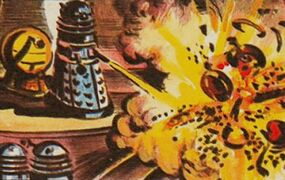
The Black Dalek Leader was feared among the Daleks as the enforcer of the Emperor's will, drones scattering when the Emperor summoned the Black Dalek Leader to face Zeg. The Black Dalek Leader itself taunted Zeg by counting down to the moment of their confrontation, although its assurance in its own victory proved premature. (COMIC: Duel of the Daleks) Due to the Black Dalek Leader's enduring loyalty and leadership as the Empire's second-in-command, the Dalek Prime viewed it as "indispensable". (COMIC: Plague of Death; PROSE: The Mutation of Time)
The Black Dalek Leader utterly despised failure. When Dalek pursuit ships failed to capture the Doctor and recover the taranium core on Desperus, it ordered them to return to Kembel. Then, immediately after, it ordered its mission controller to destroy the pursuit ships without informing their occupants. After a subsequent failure on Mira, the Black Dalek Leader, by one account, organised a recovery mission to rescue the stranded Daleks, (TV: The Daleks' Master Plan) but, according to another account, it left the unsuccessful Daleks to their fate. (PROSE: Mission to the Unknown) In the alternate timeline on Urbinia, the Black Dalek Leader ordered the use of the Time Destructor regardless of any casualties suffered by the Daleks on the planet's surface. It reasoned that any such casualties were deserved, as, had the ground forces succeeded in achieving a surrender, the Time Destructor would not have been used in the first place. (AUDIO: Daughter of the Gods) The Black Dalek Leader viewed such displays as an incentive to its subordinates to work well and make no mistakes. (PROSE: Mission to the Unknown)
When the Black Dalek Leader oversaw the Dalek City in the Emperor's absence, it displayed a more vulnerable side. When it became a carrier for the rust plague, it was overcome with guilt once it realised it was causing the deaths of other Daleks. It deliberately exposed itself to the plague to let itself die before the Emperor ordered it repaired. (COMIC: Plague of Death) However, if there was no hope of saving other Daleks, the Black Dalek Leader was willing to leave them. During the battle against the Phrynians, the Black Dalek Leader ordered Searcher One to take off before it was struck by a kamikaze attack, sparing no thought to the other saucers which did not survive. (COMIC: The Archives of Phryne)
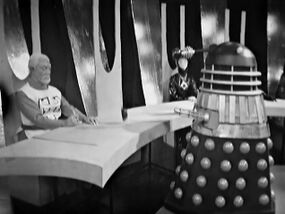
The Black Dalek Leader viewed all other species as inferior and measured the worth of any creature's life by the duration of their usefulness. This was true of the Dalek race as a whole, but, as the Daleks' representative on the Galactic Council, the Black Dalek Leader found it was necessary to adopt a certain degree of diplomacy until the Great Alliance had served its purpose. The Alliance existed primarily as a means for the Daleks to gather resources; none of the other members were trusted and the Black Dalek resented having to work with them. (PROSE: Mission to the Unknown) The Black Dalek Leader scarcely hid its true feelings from the Alliance. Very early, it declared Zephon's usefulness over, grew impatient when he failed to show up to a key conference, and when Zephon was blamed for the theft of the taranium, the Black Dalek Leader had him executed in front of the other delegates. Later, the Black Dalek Leader selected Trantis as a test subject for the Time Destructor when it felt he was growing too ambitious; when the device failed to work and Trantis survived, the Black Dalek Leader had him killed anyway. Once the Alliance had served its purpose, the Black Dalek Leader broke up the surviving delegates' with a booming, "Silence!", and then locked them up. (TV: The Daleks' Master Plan)
Before the incident on Kembel, the Black Dalek Leader had never met the Doctor, but knew of his reputation and knew him to be dangerous. Though frustrated by the Daleks' continued failure to recover the taranium core, the Black Dalek Leader considered that the development made sense once it learned of the Doctor's involvement. (PROSE: Mission to the Unknown) Persistent and strong-willed, the Black Dalek menaced the Doctor throughout many of his lives. It survived the Time Destructor's annihilation of life on Kembel still fit enough to lead the Daleks, (PROSE: Dalek: The Astounding Untold History of the Greatest Enemies of the Universe) while other survivors were driven insane by the experience. (TV: Asylum of the Daleks) When the release of the Movellan virus thwarted the Daleks' attempt to invade Earth in 1984, the Black Dalek contacted the Fifth Doctor to warn him that he had "not won", and claimed the Daleks could succeed with the duplicates instead. (TV: Resurrection of the Daleks)
At the time of the Shoreditch Incident, the Black Dalek's vulnerability emerged in full, as it was destabilised by the psychic link shared with Judith Winters. While in hibernation, it had unwelcome dreams where it experienced human sensations, which the battle computer had to counter with sedatives which left the Dalek increasingly agitated. It could think more clearly in moments where the link between itself and Winters was shut, but the girl's personality continued to filter into its own mind. At one stage, it suddenly found itself contemplating suicide. It was in this unbalanced state that the Seventh Doctor confronted the Dalek and convinced it it had no purpose. The melding of the personalities produced an overwhelming flurry of denial, fear, panic and existential dread, causing the frenzied mutant within to overload the casing, blowing it up. (PROSE: Remembrance of the Daleks)
Skills
The Black Dalek Leader was capable of critical strategic thinking. When it led the Daleks into an apparently-uninhabited region of space, its suspicions led it to uncover an entire galaxy hidden by the Phrynians' invisibility force field, precipitating the successful occupation of Phryne. (COMIC: The Archives of Phryne)
Physical appearance
As Searcher Leader One, the Black Dalek Leader's black casing sported gold accessories; the neck rings which supported its black neck grille, middle section bands atop and below the arm sockets, and the tall fender at the bottom of the lower section. The eyestalk that connected the eye lens, which appeared as a shining white disc at the face of a black ball, to the dome's pivot, along with the six discs that supported it, were coloured gold. The sense globes in the Black Dalek Leader's lower section were alternately coloured gold and silver. The dome sported two red, cone-shaped luminosity dischargers. (COMIC: The Archives of Phryne)
By the time it ordered the execution of the First Doctor, the Black Dalek Leader operated a predominantly black casing with silver slats and blue sense globes. (TV: The Chase)
Following the Dalek-Movellan War, the Supreme Dalek's casing resembled its subordinate grey Daleks. It sported white accessories; the bulb-shaped luminosity dischargers, the eyestalk discs, a mesh underneath the slats and the base unit's sense globes. (TV: Resurrection of the Daleks)
During the Shoreditch Incident, the Supreme Dalek's casing resembled its subordinate Renegade Daleks. Its accessories were now mostly silver including the neck rings, slats and mesh, the middle section band and the sense globes. Its luminosity dischargers were orange. (TV: Remembrance of the Daleks)
Behind the scenes
Voice
The Supreme Dalek was voiced by either David Graham or Peter Hawkins in its original televised appearances of the 1960s. It spoke with a higher-pitched voice than most other Daleks. Nicholas Briggs provided its voice for the novelisation audiobooks, as well as the audio story The Davros Mission and the reconstruction of Mission to the Unknown by the University of Central Lancashire.
Props
The prop for the Supreme Controller in The Dalek Invasion of Earth was the same prop used earlier in the same serial for the saucer commander, and one of the four originally constructed for use in The Daleks. The production team didn't paint it in time for the show as seen during the attack on the saucer — the Commander went in but the Supreme came out — and it was not seen during the second part of part 2 and the rest of the episode. The Black Dalek seen in The Chase, Mission to the Unknown and The Daleks' Master Plan was depicted using the same prop.[1]
The Black Dalek in Resurrection of the Daleks was depicted using by painting a hybrid prop, the top half of which was originally constructed for The Dalek Invasion of Earth with a bottom half made for exhibition at Madame Tussauds.[2]
Ironically, the Black Dalek in Remembrance of the Daleks was depicted using a prop originally constructed to serve as one of Davros' Daleks in Revelation of the Daleks.[3] The same prop appeared in Red Dwarf's Doctor Who crossover skit, and, painted grey once again, as well as having been given a new neck and eye, it appeared again as a Grey Dalek in The Curse of Fatal Death.[4]
The Black Dalek and the two other Daleks on the cover art for Daughter of the Gods were actually all sourced from the same Silver Dalek prop, photographed from different angles by Tom Saunders while on display at the Doctor Who Festival at This Planet Earth. The Supreme Dalek was then recoloured black to resemble its appearance in Master Plan. (VOR 128)
Identity
The Black Dalek first appeared in The Dalek Invasion of Earth. It soon appeared in the off-screen Daleks series, starting with the comic story Duel of the Daleks, and became a recurring character throughout The Dalek Chronicles. For years, despite widespread fandom perception of "the Black Dalek" as a singular figure, there was no explicit, definitive link made between the Black Dalek Leader of TV Century 21, the Black Dalek which appears in The Dalek Invasion of Earth and The Chase, or the Supreme Dalek(s) who went on to feature in Mission to the Unknown, The Daleks' Master Plan, and the later televised stories relating to the Imperial-Renegade Dalek Civil War. Indeed, other currents of thought began to present Black Daleks as a rank, with many non-televised stories making use of plural Black Daleks as ultimately low-ranking Dalek officers.
The first tangible connections were made by John Peel in his short story The History of the Daleks, published in 1988 in The Official Doctor Who & the Daleks Book, where the Black Dalek of the comics was explicitly identified with the Dalek Supreme of Resurrection of the Daleks and the Black Dalek of The Dalek Invasion of Earth and The Chase. Peel later wrote three novelisations, The Chase, Mission to the Unknown, The Mutation of Time and The Evil of the Daleks, as interconnected works in-line with The History of the Daleks, confirming the Black Dalek from The Chase, Mission to the Unknown and The Daleks' Master Plan as one and the same in the process. The Evil of the Daleks confirmed the Black Dalek's death in The Daleks' Master Plan, but as far as Peel was concerned, this did not cause any continuity issues due to his controversial timeline placement of The Daleks' Master Plan and The Evil of the Daleks towards the end of the Dalek timeline, postdating the events of the Imperial-Renegade Civil War. The Black Dalek's apparent, but off-screen, demise in Resurrection was easily avoided, with the novelisation of Resurrection explicitly depicting the Dalek Supreme as surviving.
Dalek: The Astounding Untold History of the Greatest Enemies of the Universe permitted the identification to stand even if one placed the televised Dalek stories in a chronological order more closely relating real-world release order: it explicitly established that the Black Dalek survived the events of Master Plan, such that the Black Dalek was indeed still serving as the Dalek Supreme by the time of Resurrection of the Daleks, Remembrance of the Daleks and related spin-off materials, establishing the Black Dalek in all these stories as one and the same. Mention of the Supreme Dalek in Destiny of the Daleks and Revelation of the Daleks can also be attributed to this Dalek.
With two appearances in The Early Adventures, those being The Sontarans and Daughter of the Gods, as well as the novelisation of Resurrection, the Black Dalek Leader was brought into the 21st century, emerging from hibernation after its last appearance in 1993's Emperor of the Daleks!.
Though it may have been achieved retroactively, the Black Dalek Leader has the distinction of being the first character originating in spin-off media to become a part of the TV series. It appeared in The Chase in 1965, just over a month after its debut in Duel of the Daleks. In this, it even beat the Dalek Prime who, despite debuting first, did not appear on television until The Evil of the Daleks in 1967.
Comic art
Because The Dalek Chronicles went through frequent art shifts, the Black Dalek Leader often changes colour and design between stories. It is black and silver in Duel of the Daleks, black and gold in Plague of Death, and black, gold and silver in The Archives of Phryne making it resemble the Black Dalek from the cinematic release Dr. Who and the Daleks. Additionally, the single colour chapter of Emperor of the Daleks! depicted it as dark purple, with its eyestalk, slats, grating section, plunger and gunstick coloured a light orange, likely meant to be gold — even though the Doctor refers to him as "the Black Dalek" on several occasions.
Reflist
- ↑ http://www.dalek6388.co.uk/dalek-invasion-of-earth/
- ↑ http://www.dalek6388.co.uk/reesurrection-of-the-daleks/
- ↑ http://www.dalek6388.co.uk/remembrance-of-the-daleks/
- ↑ https://www.facebook.com/Dalek6388/photos/following-on-from-last-weeks-post-regarding-the-remembrance-supreme-dalek-n2-and/2023214711071371/
